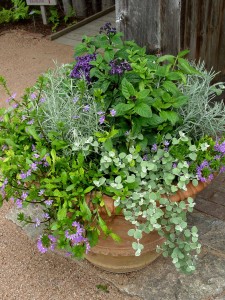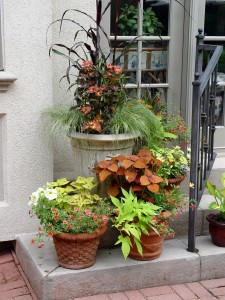8 Creative Ways to Pot Garden
May 19th, 2005
If you think gardening is going to pot lately, you’re not imagining things.
Everybody, it seems, is growing in pots these days. Or at least 26 million of us are, according to the latest estimates from the National Gardening Association.
NGA says container gardening is growing at an annual clip of 10 percent — double the rate of the overall lawn and garden industry.
There’s good reason for the pot surge:
* It’s instant gratification — long the battle cry of the Baby Boomer generation.
* It does away with gardening’s heavy-duty side — the dirty digging and incessant weeding.
* It’s versatile and forgiving. “If something doesn’t grow,” says Dr. Norman Lownds, who heads Michigan State University’s container-garden trials, “just turn it to the back and then you don’t have to look at it.”
* It allows even the poor soul with the tiniest patio to grow things.
* And with the advent of better, cheaper and even self-watering pots — plus a steady stream of enticing new plants — all of the elements are in place for a pot heyday.
The only thing holding us back now is our imagination (OK, and possibly time and the budget).
Need ideas? Here are eight creative ways to charge up your pot plans:
1.) Wild and crazy pots. Although garden centers are overflowing with more pot choices than ever, don’t stop there.
Hollowed-out logs, baskets, rusty watering cans, old boots, chimney flues and even antique potty-chairs are all possibilities.
“You can use most anything for a container,” says Crystal Huff, public programs coordinator for Hershey Gardens and an avid pot grower (the legal kind). “It just has to hold soil and have holes for drainage. At Hershey Gardens, we have plants in a bathtub.”
2.) Look at the leaves. Holly Socolow, who grows some 30 pots on her Camp Hill deck every summer, gets much of her color from foliage, not just flowers.
“I like colorful foliage because it’s there all season,” she says. “With flowers, they might be blooming and they might not. Foliage color is always there.”
She’s especially fond of coleus (an annual) but also uses ornamental grasses, perennials with showy leaves, such as coralbells and hosta, and even herbs, such as the silver-leafed woolly thyme and purple sage.
Socolow shops the entire garden center in search of plants that look good with one another.
“Anything is fair game to me,” she says. “I don’t rely just on annuals.”
3.) “Potscape.” Use a group of pots to construct an entire pot garden.
Don Hunter, a floral designer with Blooms by Vickrey in Camp Hill, mixes and matches more than 60 pots on his northern York County deck to create a series of “color groupings.”
“It’s almost like a stage setting,” he says. As plants peak and wane, he moves them in and out of the groupings.
Most of Hunter’s pots are filled with just one variety of plant each, which gives a cleaner, less cluttered look to the grouping.
“It has a specimen feel about it,” he says. “But artistically, you can do more with one type of plant per pot. As the plants grow, you can move them around and change the look.”
Hunter suggests working within one favorite color family, which in his case is purple, plum and burgundy with an occasional orange thrown in as a zinger.
4.) How about houseplants? Most of these tropical and sub-tropical natives feel right at home in our hot and humid summers.
“Foliage plants make great accents in a pot,” says Kathy Quarles, manager at Country Market Nursery. “Golden pothos, for example… you’d be amazed how tolerant it is outside.”
Snake plants — those sword-like uprights with the green and gold leaves — make ideal pot centerpieces, while red and gold variegated crotons turn a Harrisburg poolside into a Miami-looking resort.
Tropicals such as elephant ears, cannas, Ficus trees and even dwarf bananas also make excellent potted specimens.
5.) A hole-less water garden. Deck-top container water gardens are far easier than in-ground ponds. All you need is a watertight container and a few small aquatic plants.
Add a small pump with a bubbler fountain and a submerged light, and you’ve got a living, soothing feature that’s at its best after dusk.
Kits are even available to make it brainless.
6.) Grow up. The classic pot design has a tall, upright plant in the middle, but hardly anyone thinks to make this vertical element a vine.
All you need is a support, such as a bamboo tripod, a small trellis, an obelisk or one of those steel plant spirals from the garden center.
Annual vines such as mandevilla, purple hyacinth beans, morning glories or black-eyed susan vines are some of the best, but there’s even a series of Patio Clematis — woody, 6- to 8-foot, climbing perennials — that are bred specifically for containers.
7.) Pots in beds. An attractive big pot or a flower-filled urn can look great in a garden bed, surrounded by shrubs or in-ground flower brethren.
“That can become the focal point of your garden, almost like a piece of art,” says Huff. “Pots don’t have to go only on your patio.”
In-garden pots are ideal for rescuing bare spots where something has died or gone dormant (think bleeding hearts or spring bulbs), and they may be your best option in a problem bed, such as a soggy spot or underneath a Norway maple.
8.) Vary the heights. Bring a few pots up to eye level by setting one or more on a pedestal.
“A single pedestal anchors the setting for a grouping of containers,” says Peter Cilio, creative director for Quakertown-based pot-maker Campania International, “while dual pedestals can define an entryway.”
Huff says that elevating a few of the back pots in a container grouping gives more impact to the whole display. “It gives you a little dimension,” she says.
One other thing… don’t be afraid to experiment and to try whatever wacky idea strikes your fancy. It may turn out to be a disaster, but then again, it just might beat the heck out of those worn-out old red geraniums with a spike in the middle and a couple of variegated vinca vines around the edges.
Either way, you’ll be following what Socolow figures is the No. 1 rule of container gardening, which is: “Have fun.”
Container Tips
Container plants can be better and easier than in-ground plants — if you follow a few key practices:
1.) Go with big pots. “Size matters,” says Crystal Huff, public programs coordinator at Hershey Gardens. “The bigger the better. They’ll dry out less quickly.”
“I always recommend a minimum 12-inch diameter,” agrees Kathy Quarles, manager at Country Market Nursery. “Fourteen to 16 inches is ideal. Go big and you’ll have so much more success. It’s next to impossible to keep a small pot watered.”
2.) Use a lightweight soilless potting or container mix. “Don’t use soil from the garden,” says Huff. “No. 1, it probably has bugs and fungus. No. 2, it’s very heavy.”
Light potting mixes drain well and encourage rapid root development — plus it makes the pots lighter in weight if you need to move them.
3.) Get off on the right foot. Mix long-acting organic fertilizer or timed-release fertilizer such as Osmocote into the mix before planting.
To help with watering, also mix in a small amount of water-holding polymer crystals (i.e. Soil Moist, TerraSorb, Rain Gel, etc.) Line the inside of the container (but not the bottom) with plastic or weed fabric to slow evaporation.
Be sure the container has ample drainage holes in the bottom.
4.) Right plants, right place. Choose plants that are suited to the site where the pot is to go. Go with sun- and heat-loving varieties in sunny spots and shade-preferring varieties in shadier spots.
5.) Water often. That’s probably going to mean daily watering during the hot days of summer. Lack of water is the leading cause of plant death in pots.
Water enough that it drains out the holes in the bottom.
6.) Fertilize often. Soilless mixes have little or no nutrition, so you’ve got to supply it.
“I don’t think most people realize how often you have to feed plants in a soilless mix,” says Camp Hill container gardener Don Hunter. “I feed mine every two weeks with Peters Plant Food.”
Some fertilize with a half-strength, high-phosphorus fertilizer every week.
“Basically, you cannot over-fertilize (potted plants) if you have good drainage,” says Dr. Norman Lownds, a container expert at Michigan State University.
7.) Deadhead. This means snipping off spent flowers as they brown. Deadheading not only keeps potted plants looking their best but encourages repeat bloom.
Leggy or sprawling plants also can be snipped back if they’re taking over a pot.









